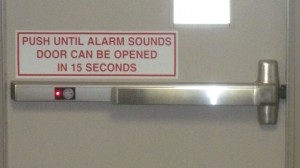 Earlier this week, we gave you the basics of delayed egress, and I discussed my love of blooper videos of people (like myself) walking into doors.
Earlier this week, we gave you the basics of delayed egress, and I discussed my love of blooper videos of people (like myself) walking into doors.
Now, part two: Delayed egress is a really easy way to decrease merchandise theft, but you have to be careful. There are many instances where delayed egress isn’t allowed because of the local AHJ (Authorities Having Jurisdiction).
Delayed Egress: Yes or No?
The biggest benefit of delayed egress is the theft deterrence it provides. If you work in the restaurant industry, you are no doubt familiar with the concept of food walking out your back door. This manages to make that a little more difficult with its buzzing alarm and timed exit.
However, your local jurisdiction is key in the decision on whether or not it’s even allowed. Some locations say it’s a-okay and are good with your installing it within your facility, while others consider it a big no-no.
So, before you do anything, make sure you check with the local AHJ and get the rules that apply to your area.
There are a couple rules, however, that are universal… which is a good thing– making your life all easy and what-not. And hey, isn’t that what I’m here for?
No matter where you are, delayed egress is not allowed on any main egress point where the majority of the occupants in you building will be residing. That’s a safety issue and, hello, we’ve all seen what people do when there’s an emergency. Typically, they check “panic” right off the top of their list before immediately stampeding towards the door. So imagine if that door had a 15-second delayed opening?
Mass. Chaos.
So, make sure you take note of that.
Also, you’re required to tie in your delayed egress to your fire system. This is another law designed to aid in the escape of people, if there were ever an emergency. When the fire system is triggered, the delayed egress feature is deactivated, allowing people to exit immediately. If you can’t somehow connect it to your fire system, you’re out of luck. This a definite must-have in the world of delayed egress.
If you take nothing else away from this post, please remember that you have to check with your AHJ before doing anything with delayed egress in your facility. It might seem like an inconvenience now, but it will definitely save you time and money in the long run. Pure and simple.
If you have any more questions about this topic, let us know! We have professionals here who are happy to answer any questions!
